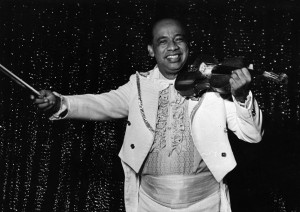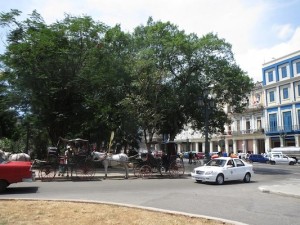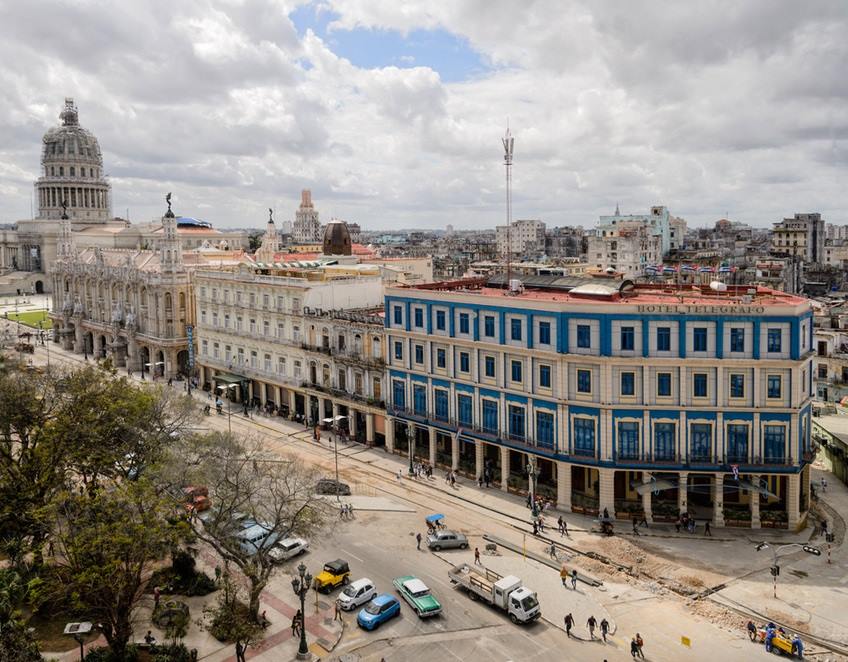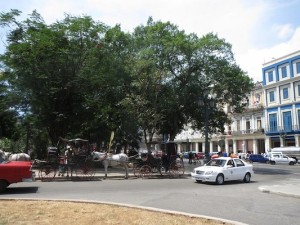![]() PRADO AND NEPTUNE, Havana. The Cha-Cha Streets..
PRADO AND NEPTUNE, Havana. The Cha-Cha Streets..
In the city of Buenos Aires there is a restaurant called Prado and Neptuno, very successful for its offer meals or other Cuban products. But the Prado and Neptuno, Havana restaurant is dedicated to Italian meals. It is rare that the commanders of the Cuban regime are not occurred to her August with cultural support containing the intersection of these two streets, inspiring one of the best known in the world Cuban rhythms. And rare is also that have not renamed the Chachachá corner.
The rarity, of course, is not its lack of expertise as marketers something that is well known-but in the fact that they have not taken full advantage of the cultural resonance of that corner, since that is all they know do: sell our traditions as tourist products, while depriving them to their rightful owner, the people.
Creator of the people.
With the death in Havana of the Cuban musician Ninon Mondejar, director of the Orquesta America closed another chapter in the musical history of Cuba, its performers and their precursors. A cycle began with a musical composition and a new rhythm that made Havana turn known corner of Prado and Neptuno over the world.
In this musical miracle then he was called cha-cha-cha and its creator was none other than the musical director of the orchestra and first violinist, teacher Enrique Jorrin, who left registered more than one genre, his own label, and which would place him among the glories of Cuban music.
The experiment was conceived in the famous habanera corner, associations “Prado and Neptuno” and “Silver Star”, in one of their ballrooms, “Amores de Verano”. It is in this room where the track would begin an era of rhythmic phenomenon runs for the first time.
“The Engañadora” the first musical number cha-cha-cha written by Jorrín leaves in a few months printed in national annals, and then worldwide, the very hallmark of this glory of Cuban music that was Enrique Jorrin .
“A Prado y Neptuno
I was a little girl
that all men had to look
He was chubby,
well formadita,
It was graciosita,
in short, colossal “.
A sticky and attractive rhythm cha-cha-cha, says the same Jorrín … It “combiné simple figures, such as black, white and quavers in 2/4. Delete cinquillo, turning the basic rhythm of the genre not syncopated scheme implemented by the guayo, cowbell and conga “.
A half century of global triumph of cha-cha-cha, let’s take a look at this popular rhythm that swept the world and immortalized one of the most famous corners of Havana, and began to Havana again in the musical cadence its performers and dancers from Buenos Aires to Tokyo, where the maestro Enrique Jorrin takes his music.
Who was the Engañadora ..?
Where had the woman who made the world to enjoy and turned the corner famous Prado and Neptune in the musical focus of an era ..? What is the origin of the Engañadora ..?
According to some sources, the teacher Jorrín was inspired by a girl who one day passed before him and a group of men who were talking in the corner of Infanta and Sites streets in Havana. Before the contempt with which the girl looked at them, one of the fans said: “Tanto story and when it comes to see are rubber”. On another occasion when Jorrín was in the late ballroom located on the corner of Prado and Neptuno, he went into a skinny girl but sported a rear bulky. A very usual artificial fashionable at the time. Once he crossed his mind the question: “Will this be another deceiver? Will you use hairpieces? “.
La Engañadora (Enrique Jorrín)
Other sources give as the inspiration for “The Engañadora” Manolo Maylan (a famous Cuban transvestite). Maylan was object in Miami of an “incident of confusion” by a US citizen, cultivated for their “feminine virtues”, he proposed marriage. Upon learning the truth, the confused suitor wanted to take the shot against Maylan … it was just “a man confused,” said Maylan questions from journalists before the press habanera collected the incident as “a passionate drama” .
The truth of all this is that the pace and “The Engañadora” conquer quickly across the continent, the world danced the majestic cha-cha-cha, which today remains healthy, full of life and energy as only a rate of tropics and the creation of the master Jorrín could reach.
Still he lives in New Town, Havana, Agueda Alvarez, who is considered the dancer who invented the steps of cha-cha-cha, one, two, three; cha … cha … cha, and he served as the first model of “The Deceitful”, accompanied in theaters and ballrooms around the world to America and Orchestra Enrique Jorrin.
“But everything in life,
We know, without even finding out,
It has been known that their forms,
Stuffed there only.
What are women loggerhead
we want to deceive.
You told me.
Nobody looks at them,
Nobody sighs,
And their pillows
Nobody wants to see.
At that time in Cuba there were 10,000 phonographs, about 100 radio stations, several television channels -for where top shows like “Cabaret Royalties” the CMQ- and countless local and establishments where people gathered to be issued listen to music and dance.
Silver Star (Enrique Jorrín)
“The Deceitful” was the first win of the master Jorrín Panart engraved with the seal, company was going through financial problems at the time. The recording brought the other side “Silver Star”, which accompanied triumphantly also the birth of the new rhythm.
As Jorrín, many interpreters of Cuban music are no longer with us, but the memories of his musical heritage will be here forever. Danceable new generations occupy our positions, it is precisely for this to continue happening, main reason for this respect and tribute to the memory of maestro Enrique Jorrin.
CUBAN PHOTOS.
![]() PRADO Y NEPTUNO, LA HABANA. LA ESQUINA DEL CHA-CHA-CHÁ.
PRADO Y NEPTUNO, LA HABANA. LA ESQUINA DEL CHA-CHA-CHÁ.
En la ciudad de Buenos Aires hay un restaurante llamado Prado y Neptuno, muy exitoso por sus ofertas de comidas u otros productos cubanos. Pero el restaurante Prado y Neptuno, de La Habana, está dedicado a comidas italianas. Es raro que a los comendadores del régimen cubano no se les haya ocurrido hacer su agosto con el soporte cultural que contiene la intersección de estas dos calles, inspiradora de uno de los ritmos cubanos más conocidos en el mundo. Y raro también es que no la hayan rebautizado como la Esquina del Chachachá.
La rareza, desde luego, no radica en su falta de pericia como comercializadores –algo que resulta bien conocido–, sino en el hecho de que no se hayan aprovechado al máximo de la resonancia cultural de esa esquina, puesto que es lo único que saben hacer: vender nuestras tradiciones como productos turísticos, al tiempo que privan de ellas a su verdadero dueño, el pueblo.
Creador del pueblo.
Con la muerte en La Habana del músico cubano Ninón Mondéjar, director de la Orquesta América, se cerró otro capítulo en la historia musical de Cuba, sus intérpretes y sus precursores. Un ciclo que comenzara con una composición musical y un nuevo ritmo que hicieran girar a la conocida esquina habanera de Prado y Neptuno sobre el mundo.
A este milagro musical de entonces se le llamó cha-cha-chá y su creador no fue otro que el director musical de esta orquesta y primer violinista, el maestro Enrique Jorrín, quien dejara inscrito, más que un género, su sello propio, y que le colocaría entre las glorias de la música cubana.
El experimento se gestó en la famosa esquina habanera, en las asociaciones “Prado y Neptuno” y “Silver Star”, en uno de sus salones de baile, “Amores de Verano”. Es precisamente en esta sala donde por primera vez se ejecuta la pieza musical que comenzaría toda una época del fenómeno rítmico.
“La Engañadora”, el primer número musical en cha-cha-chá escrito por Jorrín, deja en pocos meses impreso en los anales nacionales, y después en todo el mundo, el sello propio de esta gloria de la música cubana que fuera Enrique Jorrín.
“A Prado y Neptuno
iba una chiquita
que todos los hombres la tenían que mirar
Estaba gordita,
muy bien formadita,
era graciosita,
en resumen, colosal”.
Un ritmo pegajoso y atractivo el cha-cha-chá, según explica el mismo Jorrín… En él “combiné figuras simples, como las negras, blancas y corcheas en compás de 2/4. Suprimo el cinquillo, convirtiendo el ritmo básico del género al esquema no sincopado ejecutado por el guayo, el cencerro y la tumbadora”.
A medio siglo del triunfo mundial del cha-cha-chá, echemos una ojeada sobre este ritmo popular que recorrió el mundo e inmortalizó a una de las esquinas más famosas de La Habana, y que puso a La Habana otra vez en la cadencia musical de sus intérpretes y bailadores desde Buenos Aires hasta Tokio, donde el maestro Enrique Jorrín lleva su música.
¿Quién fue la Engañadora..?
¿De dónde salía aquella mujer que puso el mundo a gozar y convirtió a la famosa esquina Prado y Neptuno en el foco musical de toda una época..? ¿Cuál es el origen de la Engañadora..?
Según algunas fuentes, el maestro Jorrín se inspiró en una muchacha que un día pasó ante él y un grupo de hombres que conversaban en la esquina de las calles Infanta y Sitios, en La Habana. Ante el desprecio con que la muchacha les miró, uno de los admiradores le dijo: “Tanto cuento y cuando viene a ver son de goma”. En otra ocasión en que Jorrín se encontraba en el desaparecido salón de bailes situado en la esquina de Prado y Neptuno, entró una muchacha delgadita pero que ostentaba un voluminoso trasero. Una moda artificial muy usual en la época. Enseguida le pasó por la mente la pregunta: “¿Esta será otra engañadora? ¿Usará postizos?”.
La Enganadora (Ninón Mondejar)
Otras fuentes dan como inspiración de “La Engañadora” a Manolo Maylán (un famoso travesti cubano). Maylán fue objeto en la ciudad de Miami de un “incidente de confusión” por parte de un ciudadano norteamericano que, cultivado por sus “virtudes femeninas”, le propuso matrimonio. Al enterarse de la verdad, el confundido pretendiente la quiso emprender a tiros contra Maylán… Simplemente se trataba de “un hombre confundido”, manifestó Maylán ante preguntas de los periodistas de la prensa habanera que recogieron el incidente como “un drama pasional”.
Lo cierto de todo esto es que el ritmo y “La Engañadora” conquistarían en poco tiempo todo el continente, el mundo bailaba el majestuoso cha-cha-chá, que hoy se mantiene saludable, lleno de vida y de energía como sólo un ritmo del trópico y la creación del maestro Jorrín pudieran alcanzar.
Aún vive en Pueblo Nuevo, La Habana, Agueda Álvarez, a quien se le considera la bailarina que inventó los pasos del cha-cha-chá: uno, dos, tres; cha… cha… chá, y que sirvió como la primera modelo de “La Engañadora”, acompañando en teatros y salones de baile alrededor del mundo a la Orquesta América y a Enrique Jorrín.
“Pero todo en esta vida,
Se sabe, sin siquiera averiguar,
Se ha sabido que sus formas,
Rellenos tan sólo hay.
Qué bobas son las mujeres
que nos quieren engañar.
Me dijiste.
Ya nadie las mira,
Ya nadie suspira,
Ya sus almohaditas
Nadie las quiere apreciar.
En aquel entonces en Cuba había 10.000 vitrolas, alrededor de 100 emisoras de radio, varios canales de televisión —por donde se emitían magníficos programas como “El Cabaret Regalías” de la CMQ— y un sinnúmero de locales y establecimientos donde se reunía el pueblo para escuchar música y bailar.
Silver Star (Ninón Mondejar)
“La Engañadora” fue el primer triunfo del maestro Jorrín grabado con el sello Panart, compañía que pasaba por problemas financieros en esos momentos. La grabación traía del otro lado “Silver Star”, que acompañó triunfalmente también al nacimiento del nuevo ritmo.
Al igual que Jorrín, muchos intérpretes de la música cubana ya no están entre nosotros, pero los recuerdos de su herencia musical para siempre estarán aquí. Nuevas generaciones ocuparán nuestros puestos bailables, es precisamente para que esto continúe sucediendo, motivo principal de este sentido y merecido homenaje a la memoria del maestro Enrique Jorrín.
TheCubanHistory.com/Vereda Tropical / Arnoldo Varona / Internet Photos / YouTube.
THE CUBAN HISTORY, HOLLYWOOD.
Arnoldo Varona, Editor.






